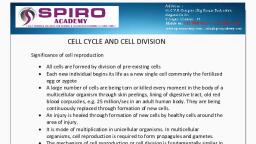Page 1 :
CHAPTER 10, , CELL CYCLE AND CELL, DIVISION, , Cell division is an inherent property of living organisms. It is a process in which cells reproduce, their own kind. The growth, differentiation, reproduction and repair take place through cell, division. Rudolf Virchow(1858) suggested ”Omnis cellula e cellula” means every cell is, derived from pre existing cell. There are two types of cell division namely Mitosis and Meiosis., The cell capable of undergoing division passes through cell cycle., 10.1CELL CYCLE:, The cell cycle is the sequence of events or changes that occur between the formation of cell, and its division into daughter cells. It has a nondividing, growing phase called Interphase and, dividing phase called mitotic or M-phase., , FIG. 10.1 CELL CYCLE, , FIG. 10.2 MITOSIS, , 1. Interphase ( inter – between, phases – aspect) : It is a long, metabolically active phase, between two successive mitotic cell division. It has three sub stages., i) G1 phase (post mitotic phase): The cell prepares for DNA, RNA and protein synthesis, ii) S phase (synthetic phase): The duplication or Replication of DNA and centriole take place, iii) G2 phase (post mitotic phase): The synthesis of proteins required for the synthesis of, spindle fibres take place
Page 2 :
2. M phase (Mitotic phase): It is a short phase. It includes two important processes that occur, simultaneously. They are Karyokinesis (division of the nucleus) and Cytokinesis (division of, the cytoplasm), resulting in two daughter cells., After ‘M’ phase the cell may enter either Interphase to repeat the cell cycle or G0 phase to arrest, cell cycle. Then the cells in G0 phase may grow and differentiate into different cell types to, perform different functions., 10.2 MITOSIS (Gr. Mitos – thread, osis – stage), Walter Flemming (1882) studied mitotic cell division in animal cells and coined the term, mitosis., Mitosis is a type of cell division in which a parental cell produces two similar daughter cells that, resemble the parental cell in terms of chromosomal number. So it is also called Equational cell, division (homotypic cell division). This maintains constant number of chromosomes in each cell, of successive generation. It occurs in somatic cells of the body. So, it is also called somatic cell, division., Mitosis occurs in two stages viz., Karyokinesis and Cytokinesis., A) Karyokinesis (Karyon – nucleus, kinesis – movement): It is the division of nuclear material., It occurs in four stages as follows:, i) Prophase (Gr. Pro – before, phases – appearance), • It is the longest phase. During this phase the chromatin is organized into distinct, chromosomes by, coiling or spiralization., • The centrioles develop into asters and move towards the opposite poles of the cell to, establish the, plane of cell division., • Spindle apparatus begin to appear, • Nucleolus and Nuclear membrane disintegrate and disappear, • The chromosomes are set free in the cytoplasm., Asters are not formed in plant cells as they do not have centrioles, hence called anastral cell division, ii) Metaphase (Meta – after, phase – appearance):, • Spindle fibres are completely formed, • The chromosome become short and thick with two distinct chromatids each, • All the chromosomes move towards the centre of the cell and arrange in the equatorial, plane, right angles to the position of asters to form metaphasic plate, • Chromosomes are attached to spindle fibres at their centromeres, Iii) Anaphase (ana – up, phases - appearance), • The centromere of all the chromosomes undergo longitudinal splitting and the, chromatids of each chromosome separate to form daughter chromosomes, • The daughter chromosomes move toward the opposite poles from the equator by the, activity of spindle fibres, Iv) Telophase (Telo – end, phases – appearance), During this, the events of prophase will be reversed, • The daughter chromosomes reach the opposite poles, • The chromosomes undergo despiralization to form long, thin thread like structures called, chromatin, • Nucleolus and nuclear membrane reappears, • The spindle fibres disappear
Page 3 :
B) Cytokinesis (cyto – cell, kinesis – movement), It is the division of cytoplasm. A cleavage furrow develops in the middle of the cell in centripetal, direction due to the contraction of microtubules. It occurs till the edges of the plasma membrane, meet. They fuse to form a separate membrane. In plant cell, the cytokinesis occurs due to the, formation of phragmoplast in centrifugal direction. The phragmoplast is formed by, golgicomplex, ER and pectin containing vesicles., , FIG. 10.3 STAGES OF MITOSIS, , Significance of Mitosis:, • It maintains genetic stability with in the population of cells derived from same parental, cell, • It helps the growth and tissue repair, • It helps in the replacement of dead and worn out cells, • It is a means of reproduction in lower organisms, 10.3 MEIOSIS: The term meiosis was coined by Former and Moore (1905), It is a type of cell division in which the daughter cells receive only half of the original set of, chromosome of the parental cell. Hence it is also called reductional division. Meiosis occurs, only in germinal cells found in male gonad (testis), female gonad (ovary) and in spore mother, cells of plants. The reproductive cells have diploid (2n) number of chromosomes. They are a, haploid paternal set and a haploid maternal set. But the reproductive cells have to undergo, meiotic division to produce the gametes containing haploid (n) number of chromosomes. The, haploid (n) male gamete (sperm) fertilizes with the haploid (n) female gamete (ovum) to produce, a diploid (2n) zygote which develops into a individual having diploid number of chromosomes in, each cell of the body. Thus meiosis helps to maintain the constant number of chromosomes for, a particular species., Meiosis takes place in two successive stages namely Meiosis I and Meiosis II. They include the, following stages.
Page 4 :
1, 2, A, , B, , Interphase, Meiosis I (reductional division), Karyokinesis I, i) Prophase I, a) Leptotene, b) Zygotene, c) Pachytene, d) Diplotene, e) Diakinesis, ii) Metaphase I, iii) Anaphase I, iv) Telophase I, Cytokinesis I, , 3, 4, A, , Interkinesis, Meiosis II (mitotic meiosis), KaryokinesisII, i) Prophase II, ii) Metaphase II, iii) Anaphase II, iv) Telophase II, , B, , Cytokinesis II, , 1. Interphase I: As you already know, during Interphase the duplication of DNA, centrioles and, synthesis of RNA and proteins take place., 2. Meiosis I: It is reductional division in which a diploid parental cell produces two haploid, daughter cells. Hence it is called reductional division. It includes following stages., A) Karyokinesis I: It is the division of nucleus that takes place in the following stages., i) Prophase I: It is the longest phase of meiosis. It has 5 sub stages., a) Leptotene: (bouquet stage), • The chromatin condenses to form chromosomes, • The chromosomes appear as long, thin and thread like structures. They undergo coiling, and become short and thick., • Each chromosome has two chromatids that are not distinctly visible., • Each chromosome shows bead like structures called chromomeres., • The telomeric ends of all the chromosomes converge towards one side of nuclear, membrane; therefore they appear horse shoe shaped. This stage is called Bouquet, stage., • Centrioles form into asters and keep moving towards opposite poles., • Spindle apparatus begin to appear, b) Zygotene (Zipper stage):, • Pairing of homologous chromosomes takes place called synapsis. The pair is called, bivalent., • The chromosome continues to undergo condensation and asters keep moving towards, opposite poles., Synapsis: Pairing of the homologous chromosomes is called Synapsis, Bivalent: A paired unit formed of homologous chromosomes consisting of a paternal and a, maternal chromosome is called Bivalent, c) Pachytene (Tetrad stage):, • The chromosomes become more short and thick, • Each bivalent shows four chromatids called tetrad, • In this stage the exchange of genetic material takes place between the non sister, chromatids of homologous chromosomes. This process is called genetic crossing
Page 5 :
over. This results in genetic recombination which is responsible for variations. The, region at which the crossing over occurs is called chiasmata (It is a visible expression of, crossing over), Tetrad: Each homologous chromosome pair (bivalent) shows four chromatids called tetrad, Crossing over: Exchange of identical parts between the nonsister chromatids of homologous, chromosomes is called Crossing over., Chiasma: These are the regions on homologous chromosomes at which crossing over occurs, (It is a visible expression of crossing over), , d) Diplotene:, • The chiasma move towards the tips of chromosomes as the homologous chromosomes, of bivalent start moving apart. This event is called Terminalisation, e) Diakinesis:, • The chromosomes at this stage appear thick, short and distinct, • The tips of some chromosome show chiasma, • Nucleolus and Nuclear membrane disappear, • Chromosomes set free in the cytoplasm, ii) Metaphase-I:• Chromosomes are arranged in the equatorial region with their centromeres towards the, poles and arms towards the equator., iii) Anaphase-I:• The Centromeres do not under go longitudinal splitting, • The chromosome of each homologous pair move towards opposite poles by the activity, of spindle fibres. This is called separation or disjunction of chromosomes., iv) Telophase-I:• The homologous chromosomes separate and reach the opposite poles, • The nuclear membrane reappears around the chromosomes at each pole, • The spindle fibres disappear, • Cytokinesis may or may not occurs, B) Cytokinesis I (cyto – cell, kinesis – movement), • It is the division of cytoplasm. A cleavage furrow develops in the middle of the cell in, centripetal direction due to contraction of microtubules. It occurs till the edges of the, plasma membrane meet. They fuse to form separate membrane. It may or may not, occur at the end of meiosis I., 3. Interkinesis, The Interphase after the first meiotic division is called Interkinesis. It may be present or absent, between meiosis-I and meiosis-II. If present it may be short or in some cases telophase-I, directly enters to prophase-II., It is similar to Interphase except for the absence of replication of DNA., 4. Meoisis-II.
Page 6 :
Meiosis-II occurs soon after meiosis-I. There is no duplication of chromosomes. Events, recognized under four stages for convenience are:-Prophase-II, Metaphase-II, Anaphase-II, and, Telophase-II., A) Karyokinesis II: It is the division of nucleus. It includes, i) Prophase-II:• The chromosomes start condensing again, • Spindle apparatus begin to appear, • The nuclear envelope and nucleolus disintegrate and disappear, ii) Metaphase-II:• The Chromosomes arrange in the equatorial region at right angles to the asters, • The Spindle fibres connect to the centromere., ., iii) Anaphase-II:• The centromeres of all the chromosomes undergo longitudinal splitting., • The chromatids of each chromosome separate and they move towards opposite, poles, iv) Telophase-II:• The chromosomes arrive at the poles and undergo decondensation to become thin, and long chromatin fibres., • A nuclear envelope is formed., • Nucleolus also appears, • The spindle fibres disappear, B) Cytokinesis II (cyto – cell, kinesis – movement), It is the division of cytoplasm. A cleavage furrow develops in the middle of the cell in centripetal, direction due to contraction of microtubules. It occurs till the edges of the plasma membrane, meet. They fuse to form separate membrane.
Page 7 :
FIG. 10.4 STAGES OF MEIOSIS, , Significance of Meiosis, • It helps to restore diploidy and maintain the constant number of chromosomes for a, species., • Meiosis produces new combination of chromosomes and genes by crossing over and by, a random distribution of paternal and maternal chromosomes to daughter cells. These, two events result in variations which are the food for speciation., SUMMARY, Cell division is an inherent property of all living organisms. The cell has to undergo division for, the growth and to maintain genetic continuity. The cell capable of division has to pass through, the cell cycle. The cell cycle is the sequence of events or changes that occur between the, formation of cell and its division into daughter cells. It has a nondividing, growing phase called, Interphase and dividing phase called mitotic or M-phase. The Interphase is a preparatory phase, having three sub stages namely G1, S and G2 phase. During Interphase replication of DNA and, protein synthesis occurs as a preparation for cell division. Mitosis includes Karyokinesis and, Cytokinesis. Karyokinesis is the division of the nucleus that occurs in four stages. They are, prophase, metaphase, anaphase and Telophase. During prophase, the chromatin condenses to, form chromosomes. centrioles develop into asters and move towards the opposite poles., Nucleolus and nuclear membrane disappears. During metaphase the chromosomes arrange, along the equatorial plane and the formation of spindle fibres takes place. During anaphase the, centromere of all the chromosomes splits and the daughter chromosomes move towards the, asters by the activity of spindle fibres. During Telophase, the daughter chromosomes reach the, poles and undergo uncoiling to form chromatin threads. The nuclear membrane and nucleolus, reappears and the spindle fibres disappear. This is followed by the division of cytoplasm
Page 8 :
resulting in two daughter cells having same number of chromosomes as that of the parental, cells. So mitotic division is also called equational division. The mitosis helps in growth, tissue, repair and replacement of dead and worn-out cells and in reproduction., Meiosis is a reductional division as the daughter cells will have half of the chromosomes to that, of the parental cell. Meiosis occurs in germinal cells to form gametes and also in spore mother, cells of plants. Meiosis occurs in two main stages namely Meiosis I and Meiosis II. The cell, enters Interphase for the preparation of cell division. Meiosis I has Karyokinesis I and, Cytokinesis I .Karyokinesis I has four sub stages namely, Prophase I, Metaphase I, Anaphase I and Telophase I. Prophase I has five sub stages. They, are Leptotene, Zygotene, Pachytene, Diplotene and Diakinesis. During Leptotene long, thin, thread like, chromatin undergoes coiling to form chromosomes showing bead like structures called, chromomeres. During Zygotene synapsis occurs and the synaptic pair is called bivalents., During Pachytene the genetic crossing over occurs to bring about recombination. During, Diplotene the homologous chromosomes start to separate and terminalization of chaisma is, noticed. During Diakinesis nucleolus and nuclear membrane disappear and chromosomes set, free in the cytoplasm. The formation of spindle fibres start. During Metaphase I the paired, chromosome arrange on the equator of the spindle fibres. During anaphase I the chromosomes, of homologous pair move towards opposite poles by the activity of spindle fibres. During this the, centromeres do not split. During Telophase I the chromosomes reach the poles and undergo, uncoiling to become long, thin, thread like structures. The nucleolus and the nuclear membrane, reappear. This is followed by Cytokinesis I resulting in two daughter cells having haploid set of, chromosomes. These daughter cells have the chromosomes with each chromosome having two, chromatids. These cells enter into Interkinesis phase. Interkinesis is similar to Interphase except, for the replication of DNA. These cells enter into meiosis II. Meiosis II has Karyokinesis II and, Cytokinesis II. The events of meiosis II are similar to mitosis. Hence it is also called mitotic, meiosis. At the end of meiosis a diploid parental produces four haploid daughter cells. Meiosis, helps to restore diploid number of chromosomes in a species. It also brings about genetic, recombinations that result in speciation.
Page 9 :
EXERCISE, 1. What is cell division? What is its significance?, 2. What is cell cycle?, 3. What is Interphase? Explain the sub stages., 4. Why mitosis is called equational cell division?, 5. What is Karyokinesis? Mention the stages in mitosis., 6. Why is cell division in plants said to be anastral?, 7. What is metaphasic plate?, 8. In which phase of mitosis the centromeres of chromosomes split?, 9. In which phase of mitosis nuclear membrane and nucleolus disappear?, 10. In which phase of mitosis nuclear membrane and nucleolus reappear?, 11. What is cytokinesis? How does it occur in animal and plant cell?, 12. Write the significance of mitosis., 13. Why is meiosis called reductional cell division?, 14. What is synapsis? When does it occur?, 15. What is bivalent?, 16. What is tetrad?, 17. What is crossing over?, 18. What is chaisma?, 19. What is terminalization?, 20. How does anaphase I differs from anaphase II of meiosis?, 21. What is Interkinesis? Explain., 22. How does Interphase differ from Interkinesis in meiosis?, 23. Write the significance of meiosis., 24. What are the differences between mitosis and meiosis?
Page 10 :
ANSWERS, 1. Cell division is a process in which cells reproduce their own kind. The growth, differentiation,, reproduction and repair take place through cell division., 2. The cell cycle is the sequence of events or changes that occur between the formation of cell, and its division into daughter cells., 3. Interphase is a long, metabolically active phase between the two successive mitotic cell, divisions. It has three sub stages., i) G1 phase (post mitotic phase): The cell prepares for DNA, RNA and protein synthesis, ii) S phase (synthetic phase): The duplication or Replication of DNA and centriole take place, iii) G2 phase (post mitotic phase): The synthesis of proteins required for the synthesis of spindle, fibres take place, 4. Mitosis is a type of cell division in which a parental cell produces two similar daughter cells, that resemble the parental cell in terms of chromosomal number. So it is also called Equational, cell division., 5. Karyokinesis is the division of nuclear material. It occurs in four stages. They are prophase,, metaphase, anaphase and telophase., 6. Asters are not formed in plant cells as they do not have centrioles, hence called anastral cell, division, 7. During metaphase, all the chromosomes move towards the centre of the cell and arrange in, the equatorial plane at right angles to the position of asters to form metaphasic plate, 8. Anaphase, 9. Prophase, 10. Telophase, 11. Cytokinesis is the division of cytoplasm. In animal cell a cleavage furrow develops in the, middle of the cell in centripetal direction due to the contraction of microtubules. It occurs till the, edges of the plasma membrane meet. They fuse to form a separate membrane. In plant cell, the, cytokinesis occurs due to the formation of, phragmoplast in centrifugal direction. The, phragmoplast is formed by golgicomplex, ER and pectin containing vesicles., 12., •, •, •, •, , It maintains genetic stability with in the population of cells derived from same parental, cell, It helps the growth and tissue repair, It helps in the replacement of dead and worn out cells, It is a means of reproduction in lower organisms, , 13. Meiosis is a type of cell division in which the daughter cells receive only half of the original, set of chromosome of the parental cell. Hence it is also called reductional division.
Page 11 :
14. Synapsis is a pairing of the homologous chromosomes. It occurs during Zygotene., 15. A paired unit consisting of homologous chromosomes of which one is paternal and the other, is maternal is called Bivalent, 16. The synaptic pair (homologous chromosomes) has four chromatids called tetrad., 17. The exchange of identical parts between the nonsister chromatids of homologous, chromosomes is called Crossing over., 18. The regions of homologous chromosomes at which crossing over occur are called chaisma., 19. The chaisma move towards the tips of chromosomes called terminalization., 20. The centromeres of chromosomes do not spilt during anaphase I unlike anaphase II., 21. The Interphase after the first meiotic division is called Interkinesis. It may be present or, absent between meiosis-I and meiosis-II. If present it may be short or in some cases telophase-I, directly enters to prophase-II., It is similar to Interphase except for the absence of replication of DNA., 22. The duplication of chromosomes (DNA replication) occurs during Interphase but not in, Interkinesis., 23., •, •, , It helps to restore diploidy and maintain the constant number of chromosomes for a, species., Meiosis produces new combination of chromosomes and genes by crossing over and by, a random distribution of paternal and maternal chromosomes to daughter cells., Recombination produces variation and variations are important in evolution., , 24., Mitosis, It is equational division, It occurs in somatic cells, Parental cell produces two daughter cells, Genetic recombination does not occur., , Meiosis, It is reductional division, It occurs in germinal cells, Parental cell produces four daughter cells, Genetic recombination occurs





















































